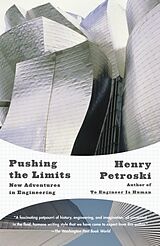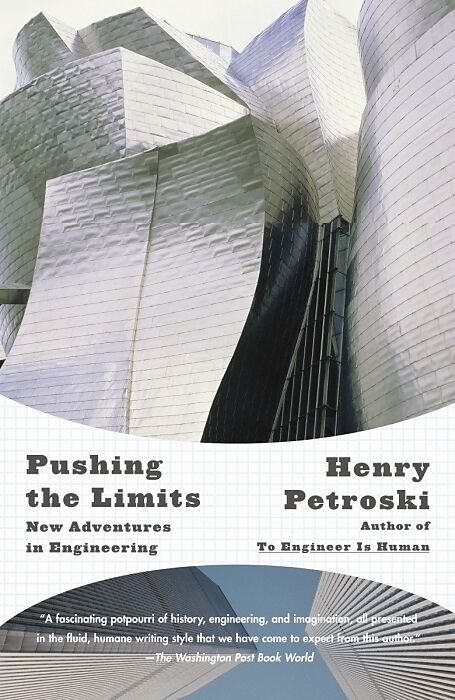Pushing the Limits
Einband:
Poche format B
EAN:
9781400032945
Untertitel:
New Adventures in Engineering
Genre:
Belletristik & Unterhaltung
Autor:
Henry Petroski
Herausgeber:
Random House USA Inc
Auflage:
Vintage Books.
Anzahl Seiten:
304
Erscheinungsdatum:
13.09.2005
ISBN:
1400032946
Zusatztext "A fascinating potpourri of history, engineering, and imagination, all presented in the fluid, humane writing style that we have come to expect from this author." -- The Washington Post Book World "A pleasure. . . . It is a measure of Mr. Petroski's skill and sensibility that his essays about structures made of steel and stone so frequently provide a sense of that large humanity, as well." -- New York Sun He writes clearly about complicated subjects, and provides lucid explanations and penetrating insights. The New York Review of Books "Henry Petroski turns an expert eye on the technology--and economics and vanity--behind [building]. The most compelling chapters concern disasters, from the collapse to the World Trade Center to the whip-snapping death of the Tacoma Narrows bridge. These essays are elegantly written and consistently thought-provoking." -- New Scientist "Henry Petroski has become the main emissary from the world of engineering to the rest of us. . . . He brings clarity and good sense to his subject, making the enigmatic world of things a little less mystifying." -- Austin American-Statesman "Petroski writes . . . with the observant eye of an engineer and the imaginative heart of a novelist." -- Los Angeles Times "An unlikely combination of mathematical brain power and a more irrational curiosity. . . . Petroski not only can put science in laymen's terms, but also can do so without killing its magic." -- The Christian Science Monitor "Petroski . . . asks us to see the extraordinary in the ordinary." -- Chicago Tribune "[There is] pleasure [in] seeing Henry Petroski's playful mind at work." -- Scientific American Informationen zum Autor Henry Petroski is the Aleksandar S. Vesic Professor of Civil Engineering and a professor of history at Duke University. The author of eleven previous books, he lives in Durham, North Carolina. Klappentext Here are two dozen tales in the grand adventure of engineering from the Henry Petroski, who has been called America's poet laureate of technology. Pushing the Limits celebrates some of the largest things we have created-bridges, dams, buildings--and provides a startling new vision of engineering's past, its present, and its future. Along the way it highlights our greatest successes, like London's Tower Bridge; our most ambitious projects, like China's Three Gorges Dam; our most embarrassing moments, like the wobbly Millennium Bridge in London; and our greatest failures, like the collapse of the twin towers on September 11. Throughout, Petroski provides fascinating and provocative insights into the world of technology with his trademark erudition and enthusiasm for the subject. Leseprobe Chapter 1 Art in Iron and Steel Works of engineering and technology are sometimes viewed as the antitheses of art and humanity. Think of the connotations of assembly lines, robots, and computers. Any positive values there might be in such creations of the mind and human industry can be overwhelmed by the associated negative images of repetitive, stressful, and threatened jobs. Such images fuel the arguments of critics of technology even as they may drive powerful cars and use the Internet to protest what they see as the artless and dehumanizing aspects of living in an industrialized and digitized society. At the same time, landmark megastructures such as the Brooklyn and Golden Gate bridges are almost universally hailed as majestic human achievements as well as great engineering monuments that have come to embody the spirits of their respective cities. The relationship between art and engineering has seldom been easy or consistent. Arguably, the assembly-line process associated with Henry Ford made workers tools of the system, but Ford also wanted to produce automobiles that were affordable to working...
Autorentext
Henry Petroski is the Aleksandar S. Vesic Professor of Civil Engineering and a professor of history at Duke University. The author of eleven previous books, he lives in Durham, North Carolina.
Klappentext
Here are two dozen tales in the grand adventure of engineering from the Henry Petroski, who has been called America's poet laureate of technology. Pushing the Limits celebrates some of the largest things we have created-bridges, dams, buildings--and provides a startling new vision of engineering's past, its present, and its future. Along the way it highlights our greatest successes, like London's Tower Bridge; our most ambitious projects, like China's Three Gorges Dam; our most embarrassing moments, like the wobbly Millennium Bridge in London; and our greatest failures, like the collapse of the twin towers on September 11. Throughout, Petroski provides fascinating and provocative insights into the world of technology with his trademark erudition and enthusiasm for the subject.
Leseprobe
Chapter 1
Art in Iron and Steel
Works of engineering and technology are sometimes viewed as the antitheses of art and humanity. Think of the connotations of assembly lines, robots, and computers. Any positive values there might be in such creations of the mind and human industry can be overwhelmed by the associated negative images of repetitive, stressful, and threatened jobs. Such images fuel the arguments of critics of technology even as they may drive powerful cars and use the Internet to protest what they see as the artless and dehumanizing aspects of living in an industrialized and digitized society. At the same time, landmark megastructures such as the Brooklyn and Golden Gate bridges are almost universally hailed as majestic human achievements as well as great engineering monuments that have come to embody the spirits of their respective cities. The relationship between art and engineering has seldom been easy or consistent.
Arguably, the assembly-line process associated with Henry Ford made workers tools of the system, but Ford also wanted to produce automobiles that were affordable to working people, and he paid his own workers sufficiently well that they could save to buy the cars they made. The human worker may have appeared to be but a cog in the wheel of industry, yet photographers could reveal the beauty of line and composition in a worker doing something as common as using a wrench to turn a bolt. When Ford's enormous River Rouge plant opened in 1927 to produce the Model A, the painter/photographer Charles Sheeler was chosen to photograph it. The world's largest car factory captured the imagination of Sheeler, who described it as the most thrilling subject he ever had to work with. The artist also composed oil paintings of the plant, giving them titles such as American Landscape and Classic Landscape.
Long before Sheeler, other artists, too, had seen the beauty and humanity in works of engineering and technology. This is perhaps no more evident than in Coalbrookdale, England, where iron, which was so important to the industrial revolution, was worked for centuries. Here, in the late eighteenth century, Abraham Darby III cast on the banks of the Severn River the large ribs that formed the world’s first iron bridge, a dramatic departure from the classic stone and timber bridges that dotted the countryside and were captured in numerous serene landscape paintings. The metal structure, simply but appropriately called Iron Bridge, still spans the river and still beckons engineers, artists, and tourists to gaze upon and walk across it, as if on a pilgrimage to a revered place.
At Coalbrookdale, the reflection of the ironwork in the water completes the semicircular structure to form a wide-open eye into the future that is now the past. One artist's bucolic depiction shows pedestrians and horsemen on the bridge, as if on a woodland trail. On one shore, a pair of well-dressed onlookers interrupt their stroll along the riverbank, perhaps to admire the bridge. On the other side of th…

Leider konnten wir für diesen Artikel keine Preise ermitteln ...
billigbuch.ch sucht jetzt für Sie die besten Angebote ...
Die aktuellen Verkaufspreise von 6 Onlineshops werden in Realtime abgefragt.
Sie können das gewünschte Produkt anschliessend direkt beim Anbieter Ihrer Wahl bestellen.
Loading...
Die aktuellen Verkaufspreise von 6 Onlineshops werden in Realtime abgefragt.
Sie können das gewünschte Produkt anschliessend direkt beim Anbieter Ihrer Wahl bestellen.
| # | Onlineshop | Preis CHF | Versand CHF | Total CHF | ||
|---|---|---|---|---|---|---|
| 1 | Seller | 0.00 | 0.00 | 0.00 |
